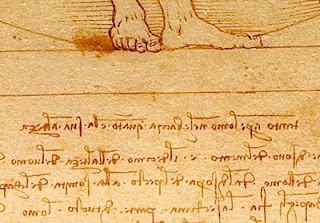I've now made it about 3/4 the way through The Da Vinci Code by Dan Brown. People claim to have read it in one sitting. The standard hardbound is 480 pages, and this large print edition is 737, so that represents quite a long "sitting"! At least eight hours, at my reading speed.
A central figure is Bishop Aringarosa. Did anyone else immediately think "Ring around the Rosie"? It is too bad that the nursery rhyme's connection with the Plague has been debunked, because Aringarosa is the prototype of a plague on humanity. Considering that so much is made of the Rose and its/her identity in the middle part of the novel, the "rosa" in his name makes me suspect more depth to his character than has so far been shown. The "posies" of the rhyme consist of whatever flowers a child may have at hand, frequently the common, weedy yard violet. I have come to think of the character as "Bishop Violet".
 When I saw the graphic of the inscription at the beginning of Chapter 71, I immediately recognized it as mirror writing. While Da Vinci is famed for employing it to (slightly) obscure his documents, it has been used by many much less famous folks.
When I saw the graphic of the inscription at the beginning of Chapter 71, I immediately recognized it as mirror writing. While Da Vinci is famed for employing it to (slightly) obscure his documents, it has been used by many much less famous folks.This image shows some of the text that appears below the Vitruvian Man illustration. I don't know what it says, because I can't read Italian, either reversed or direct. In the novel we find a couple pages of explanation as to why Saunière used English for the mirrored inscription. He was French, after all. Well, he is the creature of the author, so he can have whatever prejudices the author finds convenient.
For that matter, the Leonardo of this book is equally the author's creature. I've had a close look at high-resolution images of The Last Supper, and while the person to Christ's right does look a little too pretty to be a man, and has the longest hair in the scene, I am by no means convinced of its femaleness. Even if the real Leonardo wished to depict a woman, and was convinced that Mary Magdalene was at the Supper, that tells us more about him than about the event.
The scene in the fresco itself is ridiculous from a Biblical perspective. The twelve plus Jesus reclined; they did not sit on chairs. They may have sat around one central serving table, or perhaps there were two or more seating areas, for it was a "large upper room".
 Here is the image from above, reversed. In this one it is much easier to recognize the letters. I found out decades ago that it is not hard to write in reverse. Simply use your opposite hand. For me that is the left hand. Once your handwriting using your dominant hand is well developed and well practiced, you can take advantage of a property of the nervous system: your right and left hands are "wired" to use complementary (i.e. mirror-image) motions.
Here is the image from above, reversed. In this one it is much easier to recognize the letters. I found out decades ago that it is not hard to write in reverse. Simply use your opposite hand. For me that is the left hand. Once your handwriting using your dominant hand is well developed and well practiced, you can take advantage of a property of the nervous system: your right and left hands are "wired" to use complementary (i.e. mirror-image) motions.Draw a quick circle with your ordinary writing hand. Then do so with your other hand. It will look best if you draw the circle in the opposite direction! With much less practice than you might imagine, you can learn to write backward with that hand, and the handwriting will be the same (in a mirror) as your major hand. This is easiest to do first on a chalk board, then work toward smaller and smaller script until both hands can write at the same size, just opposite directions.
Well, back to my reading. I have a growing suspicion of the butler, since a couple chapters ago the albino Silas is wishing for a miracle, and the hidden narrator tells us that one will occur a few hours later. That's a pretty big clue, Mr. Brown!



No comments:
Post a Comment